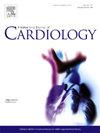Pathophysiology of heart failure with preserved ejection fraction in overweight and obesity - Clinical and treatment implications
IF 3.2
2区 医学
Q2 CARDIAC & CARDIOVASCULAR SYSTEMS
引用次数: 0
Abstract
Heart failure with preserved ejection fraction (HFpEF) is a heterogeneous syndrome with vast prevalence worldwide. Despite recent advances in understanding its pathophysiology, HFpEF remains under-diagnosed in clinical practice. Obesity-related HFpEF is a distinct and frequent phenotype with an additionally challenging diagnosis. We address the importance of overweight and obesity in HFpEF, focusing on the influence of adipose tissue in inflammation and neurohormonal activity. We also discuss atrial and ventricular remodelling in obesity-related HFpEF and potential clinical implications.
Obesity is an independent risk factor for HFpEF. Adipose tissue synthesizes aldosterone, causing lower levels of natriuretic peptide. Adipocytes dysfunction promotes a pro-inflammatory state and leads to extracellular matrix remodelling and consequently stiffening of the heart and vessels. Thus, the quantity, distribution and quality of the excess fat influences cardiovascular risk. Visceral and epicardial adipose tissue are often associated with an increased likelihood of developing HFpEF. Obesity-related HFpEF presents higher risk of left ventricular concentric remodelling and inadequate accommodation of the expanded volume due to the obesity, resulting in higher left ventricular filling pressure. Nevertheless, microvascular endothelium inflammation modifies cardiomyocyte elasticity and increases collagen deposition, which enhances myocardial fibrosis and results in HFpEF. Furthermore, neurohormonal activation may also contribute to cardiac remodelling by inducing plasma volume expansion. In turn, leptin also stimulates aldosterone synthesis and enhances renin–angiotensin–aldosterone system.
Obesity-related HFpEF presents worse overall prognosis, with increased risk of heart failure hospitalization and all-cause mortality. Intentional weight loss through caloric restriction, physical activity, pharmacological intervention and/or bariatric surgery are promising strategies.
在超重和肥胖患者中保留射血分数的心力衰竭的病理生理学-临床和治疗意义。
心力衰竭伴保留射血分数(HFpEF)是一种异质性综合征,在世界范围内广泛流行。尽管最近在了解其病理生理方面取得了进展,但HFpEF在临床实践中仍未得到充分诊断。肥胖相关的HFpEF是一种独特且常见的表型,其诊断也具有挑战性。我们讨论了超重和肥胖在HFpEF中的重要性,重点关注脂肪组织在炎症和神经激素活动中的影响。我们还讨论了肥胖相关HFpEF的心房和心室重构及其潜在的临床意义。肥胖是HFpEF的独立危险因素。脂肪组织合成醛固酮,导致利钠肽水平降低。脂肪细胞功能障碍促进促炎状态,导致细胞外基质重塑,从而导致心脏和血管硬化。因此,过量脂肪的数量、分布和质量影响心血管风险。内脏和心外膜脂肪组织常与发生HFpEF的可能性增加有关。肥胖相关的HFpEF具有较高的左室同心重构风险和肥胖导致的扩张容积调节不足,导致左室充盈压力升高。然而,微血管内皮炎症改变心肌细胞弹性,增加胶原沉积,从而增强心肌纤维化,导致HFpEF。此外,神经激素激活也可能通过诱导血浆容量扩张来促进心脏重塑。反过来,瘦素也刺激醛固酮合成和增强肾素-血管紧张素-醛固酮系统。肥胖相关的HFpEF总体预后较差,心力衰竭住院和全因死亡的风险增加。通过热量限制、体育活动、药物干预和/或减肥手术来有意识地减肥是很有前途的策略。
本文章由计算机程序翻译,如有差异,请以英文原文为准。
求助全文
约1分钟内获得全文
求助全文
来源期刊

International journal of cardiology
医学-心血管系统
CiteScore
6.80
自引率
5.70%
发文量
758
审稿时长
44 days
期刊介绍:
The International Journal of Cardiology is devoted to cardiology in the broadest sense. Both basic research and clinical papers can be submitted. The journal serves the interest of both practicing clinicians and researchers.
In addition to original papers, we are launching a range of new manuscript types, including Consensus and Position Papers, Systematic Reviews, Meta-analyses, and Short communications. Case reports are no longer acceptable. Controversial techniques, issues on health policy and social medicine are discussed and serve as useful tools for encouraging debate.
 求助内容:
求助内容: 应助结果提醒方式:
应助结果提醒方式:


